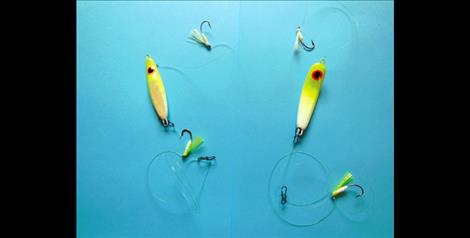Adapt fishing techniques as lake trout evolve
Hey savvy news reader! Thanks for choosing local.
You are now reading
1 of 3 free articles.
Fishermen,
Why has there been such a disparity among lake trout fishermen in the Mack Day Tournament? Some catch huge numbers while others struggle to catch just a few.
First of all to answer this question an awareness of what the extreme pressure on these fish over the last number of years has created. Typically, when a species is heavily fished a fast evolution occurs. The fish that have a genetic tendency to feed aggressively and often are the first to be eliminated from the gene pool. Those who found success jigging vigorously, spinning and trolling have found their catch much reduced.
Because many of the larger fish have been caught there is less predation and a higher survival rate of the smaller fish. Also with overall numbers of lake trout being down, the Mysis shrimp population is way up. (Note: this food source creates excellent eating red/orange fleshed fish.) Because shrimp population is so high there is a higher concentration of them in shallower water. For several years the best fishing depths were at 250 feet and deeper. Now the depth I hear the most is 220 feet. Shallower water will have a higher oxygen content, which the fish prefer if there is adequate forage. When there were more fish and fewer shrimp the fish were moving in search of food. Now with fewer fish and more forage they are not moving as much but for the most part are in excellent condition.
So, how do the changes equate into a different fishing approach?
1. Because the fish are less aggressive fishing slower is a plus
2. Because shrimp levels are so high they aren’t looking for other food sources so your bait needs to be where shrimp are and also needs to be small.
A standard setup has been a fly above a jig. This works ok but because the shrimp are on or near the bottom or a bait that is on or near the bottom will be most effective.
The most successful fishermen are using techniques that allow them to cast a heavy weight as great a distance as possible from their boats and then set their bait to the bottom as far away from the boat as they are able. A long but also sensitive pole, a full spool of braid line (Teflon-coated Kevlar) and a heavy weight with one or two flies baited with cut bait or night crawler will help keep you in the target area where the fish are feeding.
Some are using flies as small as a size 10. Others are using weighted flies, which have a tendency to keep them on or very close to the bottom.
Because your flies and jigs stir up the bottom, which draws fish, it is a good idea to cast in the same place multiple times. Change your bait often. Use strong scent along with your cut bait (shrimp, shad, anise, or even WD40 are scents that will enhance your bait. See picture, left, of my favorite setups).
Hundreds of fishermen have taken thousands of perch from the east side of Polson. Because of the numbers of big fish caught and kept it will probably become more difficult to catch the large stringers of fish. On April 21, Tim Rains and I headed to the west side of Polson Bay to see if we could find perch. We didn’t quite have as fast of action as on the east side but the fish we caught were surprisingly large. We also took a nice lake whitefish and several mountain whitefish. The three biggest were 13 inches or just shy. As soon as waters warm in the main Flathead Lake, because perch populations are on the rise, Elmo, Big Arm, Dayton, Rollins and Skidoo should all be areas with good perch fishing. With rising perch numbers the lake whitefish that become catchable when they’re feeding on perch fry will begin to bite in late July.
For more information email us, macman@ronan.net; phone us: 406-675-0068; my personal cell is 406-250-0241. Check out our tackle line at www. Zimmertackle.com
Good fishing.
















